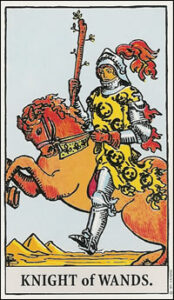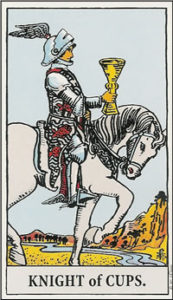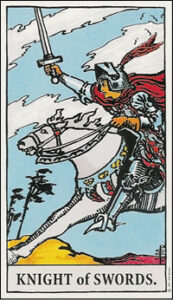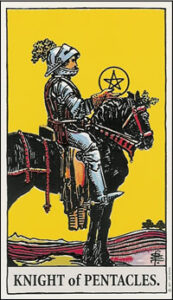In the Tarot deck, the Knights are dynamic figures — agents of movement, messengers of change, and embodiments of their suit’s energy. But beyond their symbolic meanings, their direction and posture in traditional Rider-Waite-style decks offer subtle clues about their deeper intent.
Let’s explore how each Knight’s orientation and mount reflect their inner drive — and how these visual cues can enrich your readings.
Knight of Wands: The Fiery Trailblazer

- Direction: Facing left — a surprising turn toward the past or inner world
- Mount: Rearing or in motion
- Symbolism:
- Action, adventure, impulsiveness
- Charging with passion and enthusiasm
- The horse’s movement reflects fiery energy and restlessness
- Purpose: To reignite passion, challenge inertia, or revisit a bold idea with renewed intensity
This Knight is all momentum — a spark in motion. His posture suggests boldness, but his leftward gaze hints at revisiting past passions or acting from internal drive rather than external ambition.
Knight of Cups: The Dreamy Messenger

- Direction: Facing right — gently moving into the future
- Mount: Walking slowly, almost dreamily
- Symbolism:
- Romance, idealism, emotional depth
- Introspective and sensitive
- Often seen as a messenger of love or creativity
- Purpose: To deliver emotional insight, offer healing, or initiate creative flow
This Knight moves with grace and intention. His slow pace invites reflection, but his forward-facing direction suggests openness to emotional growth and new creative journeys.
Knight of Swords: The Swift Strategist

- Direction: Facing left — charging toward the past or inner world
- Mount: Galloping aggressively, wind-blown
- Symbolism:
- Intellect, ambition, haste
- Urgency and determination
- Can also imply recklessness or charging in without full awareness
- Purpose: To cut through confusion, assert truth, or confront mental blocks
This Knight is a force of logic and speed. His posture is aerodynamic, his sword raised, his mind made up — but his leftward direction suggests he may be confronting past ideas, unresolved tensions, or internal truths with relentless force.
Knight of Pentacles: The Grounded Steward

- Direction: Facing right — oriented toward the future
- Mount: Standing still
- Symbolism:
- Responsibility, diligence, patience
- Careful planning and reliability
- The most methodical and grounded of the Knights
- Purpose: To build, sustain, and protect — often through quiet diligence
This Knight is the slowest, but the most dependable. His stillness isn’t stagnation — it’s strategy. He reminds us that progress doesn’t always gallop; sometimes it stands firm, surveys the land, and moves only when the time is right.
Interpretive Layers: Direction & Movement
Understanding the direction and posture of the Knights adds nuance to your readings. These visual cues help distinguish not just what kind of energy is present, but how and where it’s being directed.
Direction
- Facing Right (Cups, Pentacles): Future-oriented, external engagement, forward movement Suggests openness to new experiences, steady progress, or emotional growth
- Facing Left (Wands, Swords): Past-oriented, internal reflection, revisiting unresolved themes Implies introspection, returning to old passions or ideas, or confronting inner truths
Movement
- Standing Still (Pentacles): Patience, caution, contemplation Symbolizes grounded strategy, reliability, and long-term vision
- Rearing or Galloping (Wands, Swords): Urgency, passion, impulsiveness Indicates high energy, bold action, or mental intensity — but may lack caution
- Walking Slowly (Cups): Emotional or spiritual journey Reflects grace, sensitivity, and deliberate pacing
Closing Reflection
By observing the Knights’ direction and posture, we unlock a deeper layer of Tarot interpretation — one that blends visual storytelling with archetypal nuance. Whether charging leftward into inner terrain or standing firm while facing the future, each Knight reveals not just what kind of energy is present, but how it moves, where it’s aimed, and what it seeks to resolve. These subtle cues transform the Knights from static figures into living archetypes — each one a messenger in motion, shaped by intention, pace, and orientation.
Illustrations from the Rider-Waite Tarot Deck®, known also as the Rider Tarot and the Waite Tarot, were reproduced by permission of U.S. Games Systems, Inc. Stamford, CT 06902 USA. Copyright© 1971 by U.S. Games, Inc. Further reproduction is prohibited. The Rider-Waite Tarot Deck® is a registered trademark of U.S. Games Inc.

